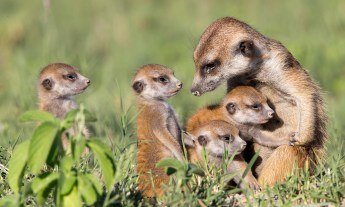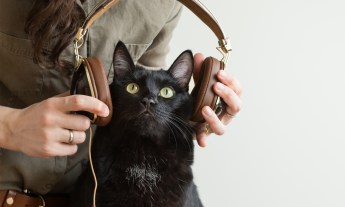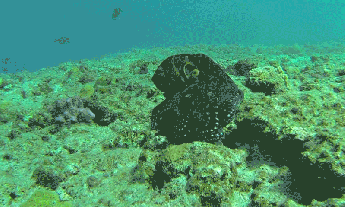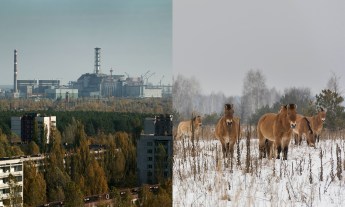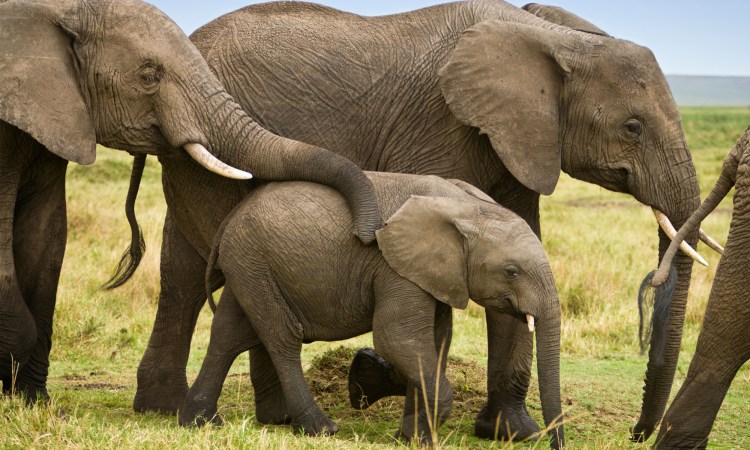
The philosopher Immanuel Kant asserted, “Man is the only being who needs education.” But if he’d said “not the only being,” he’d have been correct. Kittens who watch their mothers become better hunters faster than kittens who must figure out what claws and teeth are for. A lot of learning travels socially from parents to offspring or from elders in groups.
Throughout animal life on earth, social learning goes on all around us. In a variable world, cultures provide answers to the question of how we live and where we live, and many creatures must learn who they will be. From elders, a baby orca learns the identity of their clan and specialized hunting and traveling customs. A baby elephant learns who her family is. Songbirds learn their local dialect, bowerbirds watch elder masters build the most seductive bowers, and parrots learn who their friends are. Lions and wolves learn the specialties of their family’s hunting techniques.
When a flock of scarlet macaws lands in a tree in the Amazon rainforest, Donald Brightsmith, who’s studied them for two decades, tells me that they may use one gathering area for months. “It’s like the hot club where everybody’s going,” he says. “Then, suddenly, another spot is hot. There’s a lot going on at the cultural level.”
Culture is skills, behaviors and attractions learned and spread socially. They’re not purely instinctive. Some cultural customs are arbitrary; others are crucial for survival. But culture isn’t exclusively human.
Black bear expert Ben Kilham has rewilded hundreds of orphaned cubs. Normally, their mother introduces typical foods, situations, and dangers to them. “If you go walking with cubs,” Ben elaborates, “you see they want information.” Some plants are poisonous. What’s good? Once, Ben knew the tiny cubs he was out with had never eaten red clover. “So I found some, bent down, put it in my mouth. They rushed over and stuck their noses in my mouth, smelling. Then they immediately went searching for what I was eating, and found some red clover and ate it.”
Not by genes alone do we become who we are. Pools of knowledge — skills, courtship techniques — get relayed through generations like a torch. An individual receives only their genes from parents, but can receive culture from their whole social group. And because culture improves survival, culture can lead where genes must follow and adapt.
Culture is the things that not everyone does. All chimpanzees climb trees, so that’s not cultural. Some chimpanzee populations — not all — crack nuts. That’s cultural. Group-to-group variations in customs show what is cultural.
In Uganda, a little chimpanzee rides his mother’s back to a drying waterhole. Mother wads some moss, dips it, puts the wet sponge into her mouth, and presses out a drink. She gives her little prince the sponge. He learns how to quench dry-season thirst.
Chimpanzees have differing cultures. In Congo, chimps make nearly 30 different tools, while one population in Uganda does not use stick or stone tools at all. Only in West Africa west of the Sassandra-N’Zo river, apparently, do chimpanzees crack nuts with stones. Which nuts they choose, and how they crack them, varies among populations.
Watching their elders, young chimps learn, “This is good.” “This, avoid.” They learn where food trees are. Young chimps watch Mom’s social deference and dominance. Their long childhood, like ours, is for learning their cultured existence. That’s why it’s almost impossible for a captive chimpanzee to return to nature.
A defenseless infant sperm whale waits at the sunlit surface, while his mother hunts squid thousands of feet below. Nearby, his babysitting aunt waits her turn to dive and forage. “In a culture,” researcher Shane Gero says as we drift deep Caribbean swells off Dominica, “you are who you are because you’re with who you’re with. Because of who you’re with, you do what you do in the way that you do it.”
Each whale learns their clan’s particular movement patterns and hunting strategies. Sperm whales who encounter one another and determine — by vocal dialect — that they identify as members of the same clan may socialize. Those not sharing a dialect avoid contact. Only in sperm whales and humans does group identity extend so far beyond kin. Sperm whales clans constitute a kind of national or tribal identity at a scale larger than any other non-human.
“Behavior is what you do,” Shane sums up. “Culture is how you’ve learned to do it.”
After giving birth in the tropics, humpback whales, right whales, gray whales and others who’ve fasted several months trek back to colder waters and their food. Their little one follows. For their whole lives to come, they will travel the route learned from their mother. Eventually, their little ones will learn it. Beluga whales travel 6,000 kilometers a year along culturally learned ancestral migration routes.
Sea otters learn a foraging specialty from their mother and keep it, lifelong. Shorebirds called oystercatchers specialize in either stabbing or hammering open mussels. Chicks whose parents stab mussels develop the stabbing technique; those whose parents hammer mussels — hammer them.
“Human or otherwise,” Shane reminds me, “culture is a set of solutions to the problem of how to survive.” Social learning means that an individual can tap into collective skills accrued slowly over centuries. With social learning, one who is new and naïve in the corridors of the world gets the keys to the doors and drawers and cabinets of collective knowledge. For a young whale: Who is my group; where in a vast ocean is food? For a young elephant: Where does our family find water when our marsh goes dry? For a young chimpanzee: Now that the fruit is gone, what do I eat? For a young elk: When everything freezes where do we go? For a young lion or wolf: How do we hunt this creature that weighs several times what we weigh?
Culture creates and perpetuates unprogrammed, unplanned knowledge. Learning from elders is vastly faster than evolution that relies on genetic variations, the winnowing of survivors and the slow spread of changing genes. Socially flowing learning connects every mind that has been working on the problem of survival.
We become equipped with knowledge in at least three ways. There’s genetically inherited knowledge (instinct), trial and error (individual learning), and social learning (customs, traditions, culture). The things we learn socially give us not just skills. They also give us group identity, conformity, unity — and divisions.
Perhaps the most bizarre — and therefore instructive — example of young picking up adult culture from parents is the mallard ducking who was adopted by loons and did loony things. Mallards never ride their parents’ back (loons do, and this adopted mallard did); mallards never swim underwater (loons do, and this adopted mallard did); mallards never catch fish (loons do, and this adopted mallard ate the fish its loon-parents fed it). When a nice, normal loon family has a nice normal chick or two riding around, diving, and eating fish, we assume chicks ride parents by “instinct,” dive by “instinct,” and eat fish simply because that’s loon dinner. It takes a wayward duckling in an alien family to give us a whiff of how much cultural learning goes on, and how much flexibility exists each step of the way.
Just a few years ago, many behavioral scientists considered learning by watching “exclusively human.” But even seeing young dogs model their behavior on older dogs — for instance — reveal widespread tendencies to learn “how we do things.”
If your community has already figured out what’s safe and what to avoid, how to sing and dance, it pays to “do the done thing.” If you go it alone, you might learn — the hard way — what is poisonous, where it’s dangerous or what isn’t seductive. It’s highly practical for individuals to rely on social learning to get the tried-and-true methods.
Culture usually spreads through copying. But, “in one sense, this is the opposite of intelligent,” write culture experts Andrew Whiten and Carel van Schaik. “It could even be described as ‘mindlessly following the herd.’” We humans have “a particularly strong motivation to copy others rather than use one’s own knowledge.”
Surprisingly, human children are more slavish conformers than chimpanzees. Chimps often grasp the goal and create shortcuts. In experiments, human children often exactly copy even useless parts of sequences, such as knocking on a jar before unscrewing its lid. Chimpanzees often understand and leave out unnecessary moves. Thus, human children have been described as “apparently less rational, emphasizing the extremes of conformity to which our own, super-cultural species is often subject.”
We’ve said that culture is “the way we do things.” But to have culture, someone must do something that is not the way we do things. In 1953, one female Japanese macaque, named Imo, started washing sand and dirt off of potatoes that people had given to her group. Her innovation spread. She became famous.
Intelligence can be understood as the ability to innovate. Innovators are the most important — and the most resisted — creators of culture. Culture originates with someone doing what no one has ever done. Culture requires both innovators and adopters who conform.
Ironically, culture — a process of conformity — depends on individuals who don’t entirely conform. Without some original, untaught learner or some unschooled teacher, there is no knowledge or tradition to share; no culture to conform to. A baby whale follows their mother to one of the species’ traditional foraging spots, but the only way that such a tradition can start is that, every now and then, someone has to break with tradition, and go a new way.
Being conservative is safer than experimenting. Yet without free thinkers and innovators, nothing ever improves, no one adjusts to change, and no culture ever arises. No one drove a car until someone invented an automobile. No one played rock music until someone electrified the age-old guitar.
Conformity might work fine when the world you’re in is stable. Or justice reigns. But the world is changing very quickly now. Pigeons and sparrows have learned to get into shopping malls — sometimes by using motion-sensors to open doors — and forage the floors for crumbs. In some places, crows drop nuts on roads and wait until the light turns red before collecting their cracked prizes. They’ve answered the new question: “How can we survive in this never-before world?”
What’s needed now, among chimpanzees and among us, are a few more non-conformists to innovate adaptations to rapid changes we are causing. Cultures respond to change. When populations plummet, traditions that helped animals survive and adapt vanish silently.
Perhaps the most cautionary thing to remember is: Culture informs and facilitates survival, but culture is fragile.
Excerpted with permission from the new book Becoming Wild: How Animal Cultures Raise Families, Create Beauty, and Achieve Peace by Carl Safina. Published by Henry Holt and Company. Copyright © 2020 by Carl Safina. All rights reserved.
Watch Carl Safina‘s TED Talk here:









